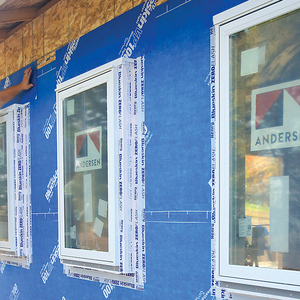About to undertake a rather complicated floor tile layout job. It consists of an entry way, a stair landing, a hallway and a kitchen – they all flow together. There are many turns, angles etc. Using 12″ tile, approx. 200 sq ft.
What would be the best way to begin. Dry layout the entire floor including cuts? dry layout the entire floor whole tile only? or what?
Also, where to start. In the middle? at one end or the other? Tips/suggestions on how to stay square and on line around this “maze”.
Thank you.




















Replies
a picture of the area would make it easier so we understand the correct layout.
Tmaxxx
Urban Workshop Ltd
Vancouver B.C.
cheers. Ill buy.
you're gonna want to "square off" something. I'd pick a center line from the main point of entry down the hall ... if it all comes off the hall.
center .. adjusted for best/least of all evils actual tile layout.
run one string line ... then ... square off that one into other areas ... and again ... square off those as need be.
best for this kinda situations ... real string over a coupla nails or screws.
lay it all out ... get the nails as close to walls as possible ... as they'll stay put longer ... and run the strings looped taught ... so they can be places and moved/removed as need be.
string the whole house if need be ...
then .. dry lay off each square to get the exact tile placement.
and adjust as necessary.
once final ... set new nails ... and restring.
having the string above the tile helps with the layout ... U can leave it up and work under ... take down and restring to check things out.
Then ... just measure off the areas and think small "boxes" of tile.
Jeff
Buck Construction
Artistry In Carpentry
Pittsburgh Pa
I'm doing EXACTLY the same thing yesterday and today. This is a swap with a friend; she gives violin lessons to the kids for a couple of years, and bought all the materials. Kitchen, breakfast nook, laundry room, and big pantry - 234 square feet. Tile is inexpensive Lowes, not particularly square or regular.
Others will disagree, but my approach is this, when many rooms have to come together with cheap tile. Snap the longest line through the rooms that you can get, at a grout line. Make 3-4-5 triangles to get nice square transverse lines. Grid the entire floor in 12 x 12 squares with the chalk line and a straightedge and a pencil; whatever it takes. I'm assuming here that, like mine, your tile are about 11-3/4 to 11-7/8" square. Otherwise, the math is tougher, but the same idea.
Now, in my case, I always place all the tiles tight into the NW corner of each grid box - just my convention so I won't forget. That way. two edges of the tile are on a line, the other two are off 1/8-1/4".
Because the tile layout is finished, now I'm safe! I go through the tile, pick out broken ones, and actually make ALL my cut pieces and edge pieces FIRST, and lay them in place.
Because of the grid lines, I can start wherever is convenient for placing tile, not for layout. I've done it where I thinset ALL the cut tile first, then come back and do the field tile. This job, I'm just installing the cut pieces along with the field tiles.
When you comb out the thinset, you can see the lines well enough through it to place the tile.
I'll post a pic tonight - should be finished. Grouting Monday.
Forrest
Edited 6/23/2006 6:10 am by McDesign
Good info. I like the string over the tile method.
McDesign, sounds like you layout ALL tiles, including cuts, then backbutter them with thinset and lay away. You'll be kneeling on the loose tiles, though.
I didn't say that the customer has already dry laid out all the full tiles (on his own) and took pictures and put them in his computer so I don't have to re-invent the wheel. He will be doing all the standing work, I'll be on my knees all week.
Even though it flows to so many different rooms, I think I'll chalk lines down the middle of each room, perpendicular and all and then start in the middle of the hallway and and work one way, and then the other.
He wants to use 1/8" spacers. Any obstacles there?
http://grungefm.com
No - I don't layout the tiles; I draw a layout on the floor. I'll post a pic in a minute.
Also, It's unlikely that the spacers will be more accurate than your eye, given the irregularities of tile.
Forrest
Edited 6/23/2006 7:30 pm by McDesign
"He wants to use 1/8" spacers. Any obstacles there?"If the tiles are all perfectly square and identical in size, then no, no obstacles.In reality, if you slavishly put a spacer at every corner of every tile, you will end up with lines that are not straight.I use the spacers frequently, but not in the corner. I put one "leg" of the spacer inbetween tile edges (NOT in the corner). But I only put one in when it looks like that's the spacing I want at that tile. Sometimes the space will need to be a bit bigger, sometimes a bit smaller.
If the layout is that large and complicated, I think I'd do Jeff's string.Rich BeckmanAnother day, another tool.
My method is probably not much different than others. We recently did a floor that was 38 feet long and between 7 and 14 feet wide. It started right inside the door from the garage and ran all the way down into a bathroom 38 feet away. Along the way it went into a powder room, a laundry closet, then into the foyer, over to the main stairs, into another closet, then into a small hallway, then into that bathroom, which had a separate water closet. It went thru or into 5 or 6 doorways and an elevator shaft along the way.
We started by stringing a line 38 feet long, and worked a little bit to make it parallel to everything. We were lucky... the house was built accurately and there were minimal parallel issues. With the string in place we started checking layout in both directions off the string. We decided on a grout joint location that gave us large cut tiles at every wall parallel to that string.
With layout determined in the long direction, we checked all of the perpendiculars and settled on a starting tile cut at the garage entry that gave us a small cut against a wall in only one place. We set out about 20 tiles with spacers in an adjacent room so that we could accurately see how the layout would grow or shrink.
The two of us spent about 2 hours optimizing the layout. Then we snapped a 38' long line and screwed a 1x2 down along that line, making sure it was perfectly straight. We were able to set 2 courses of tile all the way thru the house on the first day, and we left that to dry. In a few places we popped out to 3 or 4 courses wide where possible.
The next day we removed the 1x2 and started filling in everywhere, into the doorways, into the foyer, into the small areas.
It was a real PITA and we charged about $15 per square foot for it. When you walk in from the garage you can see a very straight line all the way down thru the house. Anything less would be a failure IMO.
Here's what I was talking about yesterday and today - you can see my blue lines on the Hardi-backer. Yes, I used mastic
View Image
View Image
View Image
View Image
Forrest
Edited 6/23/2006 9:46 pm by McDesign
Is flowing them all together the best visually, or is it being done to make the install easy?
Many tile installers forget how using boarders around key areas both slightly separates, say, the kitchen, from the surrounding area while greatly simplifying layout.
Also, following long runs with parrallel tile often times looks cheap. Diagnal tile will solve almost all your layout problems, but still requires carefully planning over the entire job.
Good building
Pick up a right angle laser and you'll save yourself a lot of time during layout and installation.
Billy
McDesign, thanks for the photo's. It is damn near the exact deal I'm talking about!!!
I think a laser will help a lot with layout and save time, any suggestions on whose to buy?
I was recently in a mall in either Denver or Twin Falls ID and the whole entire mall is tile. Very nice with borders, different size tiles, patterns and long, long runs of dead eye straight lines.
Anyone ever see it done? I am always looking at these things and would like to know how the heck they do it, how many people work in unison together to do it; it must be quite a production.
It's like 2 guys roofing the same roof at different ends, when they meet in the middle, it doesn't line up. How do the tile contractors do it?
http://grungefm.com
It's like 2 guys roofing the same roof at different ends, when they meet in the middle, it doesn't line up. How do the tile contractors do it?
The layout is predetermined and the tile setters fudge the tiles a little here and there to stick to the the layout so it doesn't look fudged, but is.
Large jobs are also separated into sections so the various people know that their wook needs to be spot on along the edges where it joins the work of others.
If roofers took the same care in laying out a roof and fudged a little here and there, they'd line up seamlessly as well.
Most people don't notice the slight differences in tile dimensions, but in reality, all tile jobs are an excercise in fudging in the right places to one extent or another.
:-)
http://www.robotoolz.com/RT-7610-5/RT-7610-5.htmlTmaxxx
Urban Workshop Ltd
Vancouver B.C.
cheers. Ill buy.
Thanks for the link, tmaxxx. In reading about the P/C laser level, it can mount to a tripod,,,,,,,,,, but does it have to be mounted? Can it be set on the floor, on the tile, and still project the laser beam for layout? Is it self leveling or does it need to be leveled at the tripod?
$170.00 @ Amazon.com.
http://grungefm.com
no tri pod needed. self leveling. it shoots beams, not lines so im not sure how you would use it on a tripod to lay out floor tile. i use it for shooting marks over distances and for settng perpendicular lines.Tmaxxx
Urban Workshop Ltd
Vancouver B.C.
cheers. Ill buy.
I'm making so damn much money working 24/7, I think I'll pick one up.
Good idea, neighbor to the north.
http://grungefm.com
Dude, you should switch to half days... like maybe 7 AM to 7 PM every day instead. It's a lot easier on your personal life.
Whoa,,,,,,,,,,whoa.
You have a personal life? No way.
Can I have one too?
I do get some great ideas here,,,,,maybe, just maybe, the 7-7 thing might work, too. I'll be giving it a try.
You know, always trying to better myself and all.
http://grungefm.com
Grouted and out of there
View Image
Forrest
Thats a nice job!! I always take photos pre-grout because it shows the tile better.
I looks fairly close to the type of project I'll be doing the last week of July.
What kind of knee pads do you use?
http://grungefm.com
Umm - they're orange hard shell 2-piece, jointed in the middle, padded on the lower section, elastic straps - I'll have to check the name.
Forrest